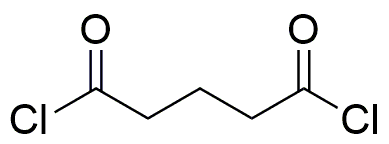Glutaryl chloride is widely utilized in research focused on:
- Synthesis of Pharmaceuticals: It serves as an important intermediate in the production of various pharmaceutical compounds, enhancing the efficiency of drug development processes.
- Polymer Production: This compound is used in the synthesis of polyamides and polyesters, which are vital in creating durable materials for textiles and automotive applications.
- Chemical Reagents: Glutaryl chloride acts as a reagent in organic synthesis, facilitating the formation of complex molecules in laboratory settings.
- Biochemical Research: It is employed in the modification of biomolecules, aiding researchers in studying enzyme activity and protein interactions.
- Agrochemical Development: The compound is utilized in the formulation of agrochemicals, contributing to the development of effective pesticides and herbicides.
General Information
Properties
Safety and Regulations
Applications
Glutaryl chloride is widely utilized in research focused on:
- Synthesis of Pharmaceuticals: It serves as an important intermediate in the production of various pharmaceutical compounds, enhancing the efficiency of drug development processes.
- Polymer Production: This compound is used in the synthesis of polyamides and polyesters, which are vital in creating durable materials for textiles and automotive applications.
- Chemical Reagents: Glutaryl chloride acts as a reagent in organic synthesis, facilitating the formation of complex molecules in laboratory settings.
- Biochemical Research: It is employed in the modification of biomolecules, aiding researchers in studying enzyme activity and protein interactions.
- Agrochemical Development: The compound is utilized in the formulation of agrochemicals, contributing to the development of effective pesticides and herbicides.
Documents
Safety Data Sheets (SDS)
The SDS provides comprehensive safety information on handling, storage, and disposal of the product.
Product Specification (PS)
The PS provides a comprehensive breakdown of the product’s properties, including chemical composition, physical state, purity, and storage requirements. It also details acceptable quality ranges and the product's intended applications.
Certificates of Analysis (COA)
Search for Certificates of Analysis (COA) by entering the products Lot Number. Lot and Batch Numbers can be found on a product’s label following the words ‘Lot’ or ‘Batch’.
*Catalog Number
*Lot Number
Certificates Of Origin (COO)
This COO confirms the country where the product was manufactured, and also details the materials and components used in it and whether it is derived from natural, synthetic, or other specific sources. This certificate may be required for customs, trade, and regulatory compliance.
*Catalog Number
*Lot Number
Safety Data Sheets (SDS)
The SDS provides comprehensive safety information on handling, storage, and disposal of the product.
DownloadProduct Specification (PS)
The PS provides a comprehensive breakdown of the product’s properties, including chemical composition, physical state, purity, and storage requirements. It also details acceptable quality ranges and the product's intended applications.
DownloadCertificates of Analysis (COA)
Search for Certificates of Analysis (COA) by entering the products Lot Number. Lot and Batch Numbers can be found on a product’s label following the words ‘Lot’ or ‘Batch’.
*Catalog Number
*Lot Number
Certificates Of Origin (COO)
This COO confirms the country where the product was manufactured, and also details the materials and components used in it and whether it is derived from natural, synthetic, or other specific sources. This certificate may be required for customs, trade, and regulatory compliance.

